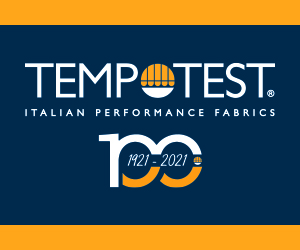Arley Cuts Costs with Overseas Manufacturing of 'American Home' Products
April 3, 2001
New York – With the acquisition of American Home in March 1999, the well-known window and bedding producer Arley was able to add sales volume without adding domestic manufacturing support. That's because most of the American Home line – which includes coordinated comforter sets, bed-in-a-bag and bedding in solid color sets including sateens – is made overseas.
"The only production done domestically for American Home is filling comforters," said Greg Reilly, vice president of sales and marketing for American Home. "We are also in a joint venture with Bassetti for our line of high-end photographic prints." The American Home range quickly became the stating numbers at retail, and Arley/American Home claimed more placements in 2000 than in 1999 for its products.
The company still buys domestically for its higher end line, offering more detail at higher prices in printed, woven and jacquard fabrics. But American Home, primarily a print line in volume price points, is produced almost completely offshore. Pakistan is currently a favorite source.
"The import business has to grow. We have managers in each of our divisions who keep an eye on imports. The most modern equipment is in Pakistan, where we will continue to do more and more printing, dyeing, cut-and-sew and the development of screens," said Reilly. "There isn't any screen charge in Pakistan. We find that Pakistan is more project-oriented. When we say, 'Do this for us' – they'll do it well." The company also has a denim bedding line made in Pakistan.
For window treatments, on the other hand, there are many more offshore suppliers to choose from. At the moment, Reilly figures that while 65 percent of Arley's bedding business is still domestic, over half of its curtains come from offshore sources. The company buys sheers and knitted curtains in Turkey.
"The Turks own the tergal market and the high twist voile market. At Heimtextil this year, we noticed that every Asian stand had a tab-topped curtain on display. Indian suppliers showed wool-shaggy chic curtains for the 'tweener market.' We saw wood and plastic beaded window treatments from China. We see more innovation outside the U.S.A. in the window area. Overseas resources are trying very hard to be innovative."
This oversupply of window treatments, combined with the demise of several large U.S. retailers, has stiffened the competition in window fashions for companies like Arley. According to Reilly, however, the right look is still the key to sales in the curtain market. "Window fashions have gotten further removed from the bedding business," said Jerry Pittman, vice president and national sales manager of Window and Bedding. "We've had to retool our curtain business. With Ward's and Bradlees out of the picture, who is going to buy kitchen curtains at retail?" he asked. "We're picking markets where there is still gross margin left. Everyone has a target price but if you come in with the right look, the retailer will buy it."
Some retailers have tried to source their goods directly from the manufacturers in order to cut their costs, but Reilly believes that his company is not about to lose its business. "If retailers want to import directly from offshore, substantial minimums are involved. You start bringing in multiple SKUs. You simply cannot be right all of the time and your store have concerns about too much inventory. We take EDI orders over the weekend from the retailer, ship by Thursday or Friday – about three weeks from receipt of order. Inventory management becomes crucial. Reorder becomes stock intensive. We keep open stock and we take the risk so that retailers do not have to. You can order 100 pieces at a time if you want to. Many retailers have found out the hard way that sourcing directly is not easy."
Arley tries to keep at least some of its production on shore, especially for operations that are less labor intensive but which add value to the products. The U.S. still has sophisticated machinery that some of the offshore producers don't have yet, he explained.
"Our goal is not to be 100 percent imports," said Reilly. "We take advantage of the logistics. Imports work well when you're selling a lot of narrow and deep ranges – not wide and shallow. Our capabilities in the U.S.A. have to do with multi-needle work – the ability to scallop, cut and sew embellishments, laces, ruffles, attachments – complicated cutting operations done by machine – not handwork."
"The only production done domestically for American Home is filling comforters," said Greg Reilly, vice president of sales and marketing for American Home. "We are also in a joint venture with Bassetti for our line of high-end photographic prints." The American Home range quickly became the stating numbers at retail, and Arley/American Home claimed more placements in 2000 than in 1999 for its products.
The company still buys domestically for its higher end line, offering more detail at higher prices in printed, woven and jacquard fabrics. But American Home, primarily a print line in volume price points, is produced almost completely offshore. Pakistan is currently a favorite source.
"The import business has to grow. We have managers in each of our divisions who keep an eye on imports. The most modern equipment is in Pakistan, where we will continue to do more and more printing, dyeing, cut-and-sew and the development of screens," said Reilly. "There isn't any screen charge in Pakistan. We find that Pakistan is more project-oriented. When we say, 'Do this for us' – they'll do it well." The company also has a denim bedding line made in Pakistan.
For window treatments, on the other hand, there are many more offshore suppliers to choose from. At the moment, Reilly figures that while 65 percent of Arley's bedding business is still domestic, over half of its curtains come from offshore sources. The company buys sheers and knitted curtains in Turkey.
"The Turks own the tergal market and the high twist voile market. At Heimtextil this year, we noticed that every Asian stand had a tab-topped curtain on display. Indian suppliers showed wool-shaggy chic curtains for the 'tweener market.' We saw wood and plastic beaded window treatments from China. We see more innovation outside the U.S.A. in the window area. Overseas resources are trying very hard to be innovative."
This oversupply of window treatments, combined with the demise of several large U.S. retailers, has stiffened the competition in window fashions for companies like Arley. According to Reilly, however, the right look is still the key to sales in the curtain market. "Window fashions have gotten further removed from the bedding business," said Jerry Pittman, vice president and national sales manager of Window and Bedding. "We've had to retool our curtain business. With Ward's and Bradlees out of the picture, who is going to buy kitchen curtains at retail?" he asked. "We're picking markets where there is still gross margin left. Everyone has a target price but if you come in with the right look, the retailer will buy it."
Some retailers have tried to source their goods directly from the manufacturers in order to cut their costs, but Reilly believes that his company is not about to lose its business. "If retailers want to import directly from offshore, substantial minimums are involved. You start bringing in multiple SKUs. You simply cannot be right all of the time and your store have concerns about too much inventory. We take EDI orders over the weekend from the retailer, ship by Thursday or Friday – about three weeks from receipt of order. Inventory management becomes crucial. Reorder becomes stock intensive. We keep open stock and we take the risk so that retailers do not have to. You can order 100 pieces at a time if you want to. Many retailers have found out the hard way that sourcing directly is not easy."
Arley tries to keep at least some of its production on shore, especially for operations that are less labor intensive but which add value to the products. The U.S. still has sophisticated machinery that some of the offshore producers don't have yet, he explained.
"Our goal is not to be 100 percent imports," said Reilly. "We take advantage of the logistics. Imports work well when you're selling a lot of narrow and deep ranges – not wide and shallow. Our capabilities in the U.S.A. have to do with multi-needle work – the ability to scallop, cut and sew embellishments, laces, ruffles, attachments – complicated cutting operations done by machine – not handwork."
















